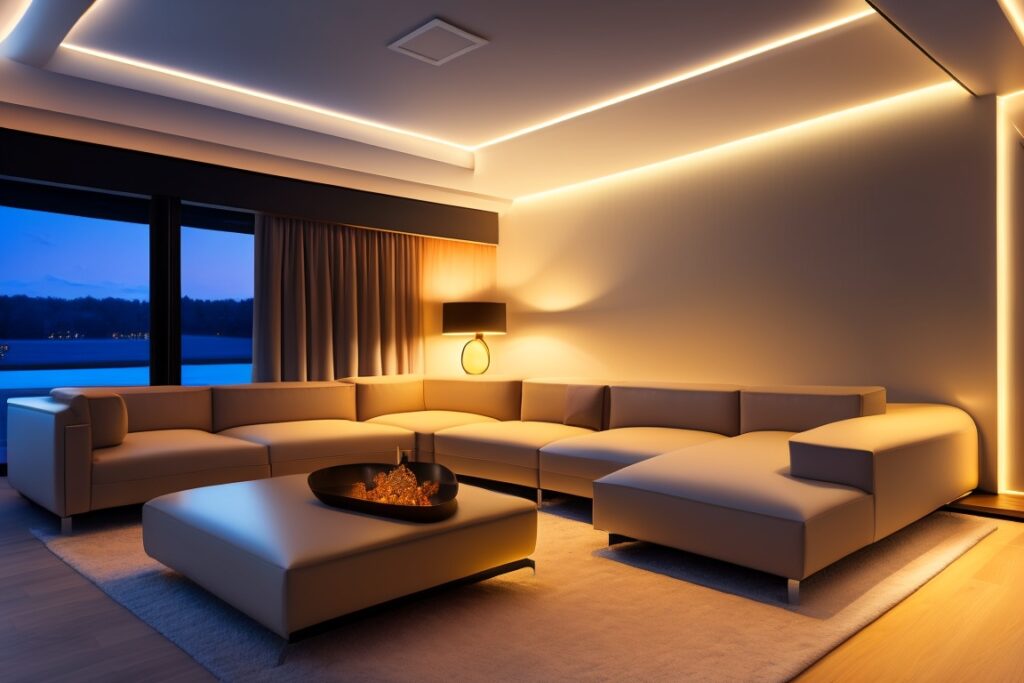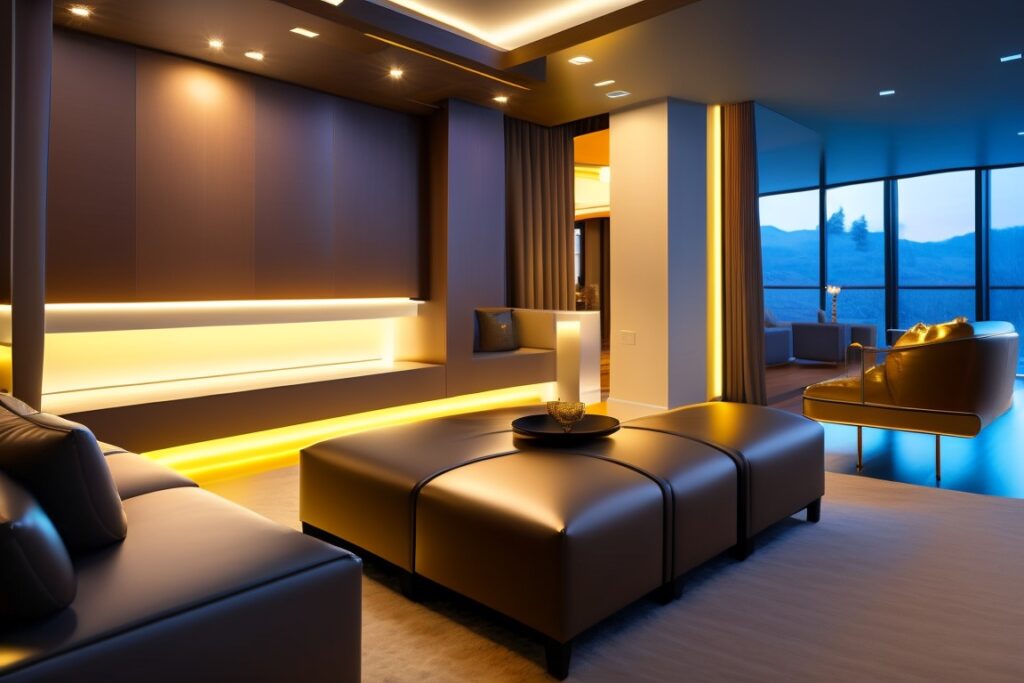In today’s fast-paced world, lighting plays a crucial role in enhancing our living spaces. With advancements in technology, LED strip lights have emerged as a popular choice for both residential and commercial applications.
These versatile lighting solutions offer a wide range of benefits, including energy efficiency, durability, and customizable ambiance. But just how bright are LED strip lights?
In this article, we will delve into the intricacies of LED strip light brightness and explore their practical applications.
Table of Contents
Understanding LED Strip Light Brightness
What is Lumen?
Lumen is the standard unit used to measure the brightness of light. It represents the total amount of visible light emitted by a source in all directions. The higher the lumen value, the brighter the light output will be.
Importance of Lumen in LED Strip Lights
Lumen plays a vital role in determining how well an LED strip illuminates a given space. It directly impacts the visibility and intensity of the light, making it a crucial factor to consider when choosing the right LED strip for your lighting project.
How Bright Are LED Strip Lights?
LED strip lights come in a variety of brightness levels, which are measured in lumens. The brightness of LED strip lights depends on factors such as the number and type of LEDs per meter or foot and the power consumption of the LED chips used.
Typically, LED strip lights range from about 100 to 1,000 lumens per meter or more. The lower end of this range is suitable for accent lighting and decorative purposes, while the higher end is used for task lighting or general illumination. Keep in mind that the brightness of the LED strip lights can vary depending on the specific product and manufacturer.
When choosing LED strip lights, consider the lighting application and the desired level of brightness you need. Additionally, the color temperature of the LEDs (measured in Kelvin) will also affect the perceived brightness and ambiance of the light.
For specific lighting needs, it’s always a good idea to check the product specifications and customer reviews to ensure you get the right brightness for your intended use.

Factors Affecting LED Strip Light Brightness
LED Chip Type and Quality
The quality of LED chips used in the strip greatly influences its brightness. High-quality chips produce more lumens per watt, resulting in brighter illumination.
LED Density per Meter
The number of LEDs per meter affects the brightness and evenness of the light distribution. A higher LED density generally means a brighter output, but it may also increase power consumption.
Power Consumption and Efficiency
Power consumption efficiency plays a significant role in determining the brightness of LED strips. Efficient LED strips convert a higher percentage of electrical power into visible light, resulting in better brightness and lower energy costs.
Choosing the Right Brightness Level for Your Needs
Consider the Lighting of Space
The size and purpose of the space you want to illuminate will guide your decision on the brightness level. Larger areas may require higher brightness to achieve adequate illumination.
Desired Ambiance and Application
Different applications call for varying brightness levels. For accent lighting or decorative purposes, lower brightness may be sufficient. Task lighting or areas that require high visibility may require brighter LED strips.
LED Strip Brightness Levels Explained
Low Brightness LED Strips
Low brightness LED strips provide subtle accent lighting. They are ideal for creating a cozy or ambient atmosphere in spaces such as bedrooms or living rooms.
Medium Brightness LED Strips
Medium brightness LED strips offer a balance between accent and task lighting. They are suitable for areas where moderate illumination is required, such as kitchens, offices, or retail displays.
High Brightness LED Strips
High-brightness LED strips deliver powerful illumination and are suitable for applications that require bright lighting, such as outdoor areas, large commercial spaces, or signage.
Practical Applications of Different Brightness Levels
Accent Lighting and Decoration
Low and medium-brightness LED strips are commonly used for accent lighting and decoration. They can be used to highlight architectural features, create visual interest, or add a touch of elegance to any space.
Task Lighting
Medium to high-brightness LED strips are ideal for task lighting purposes. They provide focused and bright illumination, making them suitable for activities that require high visibility, such as reading, cooking, or working.
General Ambient Lighting
Medium to high-brightness LED strips can also be used for general ambient lighting. They offer uniform and sufficient illumination for larger areas, ensuring a well-lit and comfortable environment.

Installation Tips for Maximum Brightness
Proper Placement and Alignment
To maximize brightness, ensure proper placement and alignment of the LED strip. Position it close to the intended surface and ensure an even spread of LEDs for uniform light distribution.
Power Supply Considerations
Choose an appropriate power supply that matches the voltage and wattage requirements of your LED strip. Insufficient power can lead to decreased brightness and performance.
Thermal Management
Heat can affect the brightness and lifespan of LED strips. Adequate thermal management, such as using aluminum profiles or heat sinks, can help dissipate heat and maintain optimal brightness levels.
Maintenance and Longevity of Brightness
Regular maintenance is crucial to preserve the brightness and longevity of LED strips. Keep the strips clean, check for any damaged components, and replace faulty LEDs promptly to ensure optimal performance.
Energy Efficiency and Cost Savings
LED strip lights are highly energy-efficient compared to traditional lighting options. Their low power consumption translates into reduced electricity bills, making them a cost-effective lighting solution in the long run.
Addressing Common Myths about LED Strip Brightness
Myth: Higher Wattage Means Brighter LED Strips
Contrary to popular belief, wattage alone does not determine the brightness of LED strips. The quality of LEDs, lumen output, and efficiency also play significant roles in determining the brightness level.
Myth: LED Strip Brightness Doesn’t Matter for Decoration
LED strip brightness is essential for creating the desired ambiance and visual impact in decorative applications. Choosing the right brightness level enhances the overall aesthetics and appeal of the space.
Conclusion
LED strip lights offer a versatile and efficient lighting solution for various applications. Understanding the concept of LED strip light brightness is crucial for selecting the right product that matches your specific needs.
By considering factors like lumen output, LED chip quality, and density, you can ensure optimal brightness and create the desired lighting atmosphere. R
Remember to choose the appropriate brightness level based on the space, application, and desired effect. With LED strip lights, you can transform any space with brilliant illumination and energy-efficient lighting.
Read More:-
- Sloped Ceiling Lighting Ideas: Illuminating Your Style
- Types of parking lot lights
- How to Put Up LED Lights and Create a Stunning Home Display
- How to get a blacklight on led lights?
FAQs
Are LED strip lights as bright as traditional light bulbs?
LED strip lights can be as bright, if not brighter, than traditional light bulbs. However, it ultimately depends on the specific LED strip’s brightness level and the wattage of the traditional bulb being compared.
Can I dim LED strip lights to adjust the brightness?
Yes, many LED strip lights come with dimmable options. By using compatible dimming devices or controllers, you can easily adjust the brightness levels according to your preferences.
How long do LED strip lights typically last?
LED strip lights have a long lifespan and can last for tens of thousands of hours. The exact lifespan may vary depending on factors such as usage, quality of the LEDs, and operating conditions.
Can I cut LED strip lights to adjust the length and brightness?
Yes, LED strip lights are often designed to be cut at specific intervals. Cutting them allows you to customize the length and adjust the brightness to suit your needs.
Are LED strip lights suitable for outdoor use?
Yes, there are LED strip lights specifically designed for outdoor use. These strips are weather-resistant and can withstand exposure to moisture, dust, and other outdoor elements.